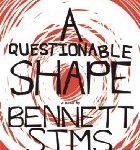
 A Questionable Shape by Bennett Sims (Two Dollar Radio, 2013)
A Questionable Shape by Bennett Sims (Two Dollar Radio, 2013)
I love a good zombie novel. The trick to making a good zombie novel is nuance. You don’t need moaning hordes constantly dismembering innocent bystanders. If innocent bystanders are too busy fearing for their lives, they’ll never have time to ruminate on, in philosophical terms, the zombie-ness of the zombies. If the zombies aren’t quarantined for public safety, citizens won’t be able to move on and try to navigate the post-epidemic world. A nuanced, philosophical look at life with the undead is exactly what Bennett Sims gives us in A Questionable Shape.
Three months after the epidemic began and a week before hurricane season officially starts in Baton Rouge, government officials are trying to round up the straggling undead for quarantine and best friends Vermaelen and Mazoch are desperately searching for Mazoch’s missing father. They have a week left to search. Officials have determined that the undead somehow navigate toward the places that were important to them while they were alive, so Mazoch has created a list of possible search areas for his father.
On the one hand, they are creatures of pure memory: they return only to sites from their past, and can find their way back to neighborhoods buried far into their childhoods. But on yet another hand (and this is turning out to be a real Shiva of dialectical reasoning), they are creatures of pure forgetfulness: the sites they return to, so potent with mortal nostalgia, mean nothing to them, and they navigate them unconsciously, are as sleepwalkers there.
Vermaelen, serving as narrator, is not an easy person to sit and ruminate with. Between his ten-dollar words, his indecisiveness, and his penchant for footnotes, he’s quite maddening. He even relates the footnote to the undead.
Since the outbreak, I have often reflected that the footnote is the typographic mark most emblematic of undeath. By opening up a subjacent space on the page, the footnote digs a grave in the text, an underworld in the text. The words that are banished there are like thoughts that the text has repressed, pushed down into its unconscious. But they go on disturbing it from beneath, such that if the text were ever infected, they are the words that would guide it. Footnotes are a text’s phantom feet.
But maddening as he may be, Vermaelen’s analysis of the undead epidemic is fascinating. His girlfriend, Rachel, and Mazoch debate how to categorize the undead. Rachel volunteers in a quarantine facility with the undead and feels they are just “people with a disease.” Mazoch believes they are “contagious cannibals.” Although he’s only seen one undead (in the middle of night, two blocks away), Vermaelen eschews categorizing the undead and instead obsesses over what being undead might actually feel like. He’s spent most of his post-epidemic time reading every available article on the undead and their behavior. He pores over FIGHT THE BITE, a government-issued guide to surviving and thriving around the undead. What, if anything, do those milky white eyes see? What do those ever-rotting hands feel as they tear apart another human being? Vermaelen considers the philosophical ramifications of undead hands through a Heidegger lens.
If an infected breaks into its old bedroom, and its hand roots under the bed for the hammer that it ‘knows’ is there, then doesn’t the infected also ‘know’ the equipmental totality of the mattress, bed, room, and house, that is, the entire Being-in-the-World of its quondam Dasein, which is to say, couldn’t the infected be, in some qualified way, precisely the same Dasein? And in the case of Frankenstein’s monster, these ontological ramifications multiply mind-bogglingly across all of his limbs. Because each hand wants to root for a different tool from a different life, and because each foot wants to walk toward a different home—because the monster has to coordinate all of his limbs independently, just to stumble forward and turn a doorknob—it’s as if his entire body were a gangline of Daseins, pulling the musher of his madman’s brain.
But his pondering doesn’t stop at the philosophical. Vermaelen also imagines how his own hands may act if he were to be infected.
They would be before-hands. And so they would never adopt new habits, in undeath. They would not try to play the piano, for instance, or to casually vandalize my apartment. Even if they did things that I never did with them (like tear into another person’s flesh), they would do them somewhat in my manner: ripping to the meat in the same way that, at barbeques, they used to rip into ribs.
A Questionable Shape is not a quick and easy read, but it is a satisfying one. It’s not often you get an intellectually stimulating zombie novel that includes references to just about everything—video games, famous philosophers, paintings, and movies. To fully appreciate A Questionable Shape, you have to spend time with it, digesting and savoring the myriad musings of Vermaelen. To rip into it like an undead would its latest victim is to miss out on a great addition to the literary zombie genre.
What kind of zombie novels do you enjoy? Do you prefer to be kept up at night by terror and suspense or philosophical meditations?





